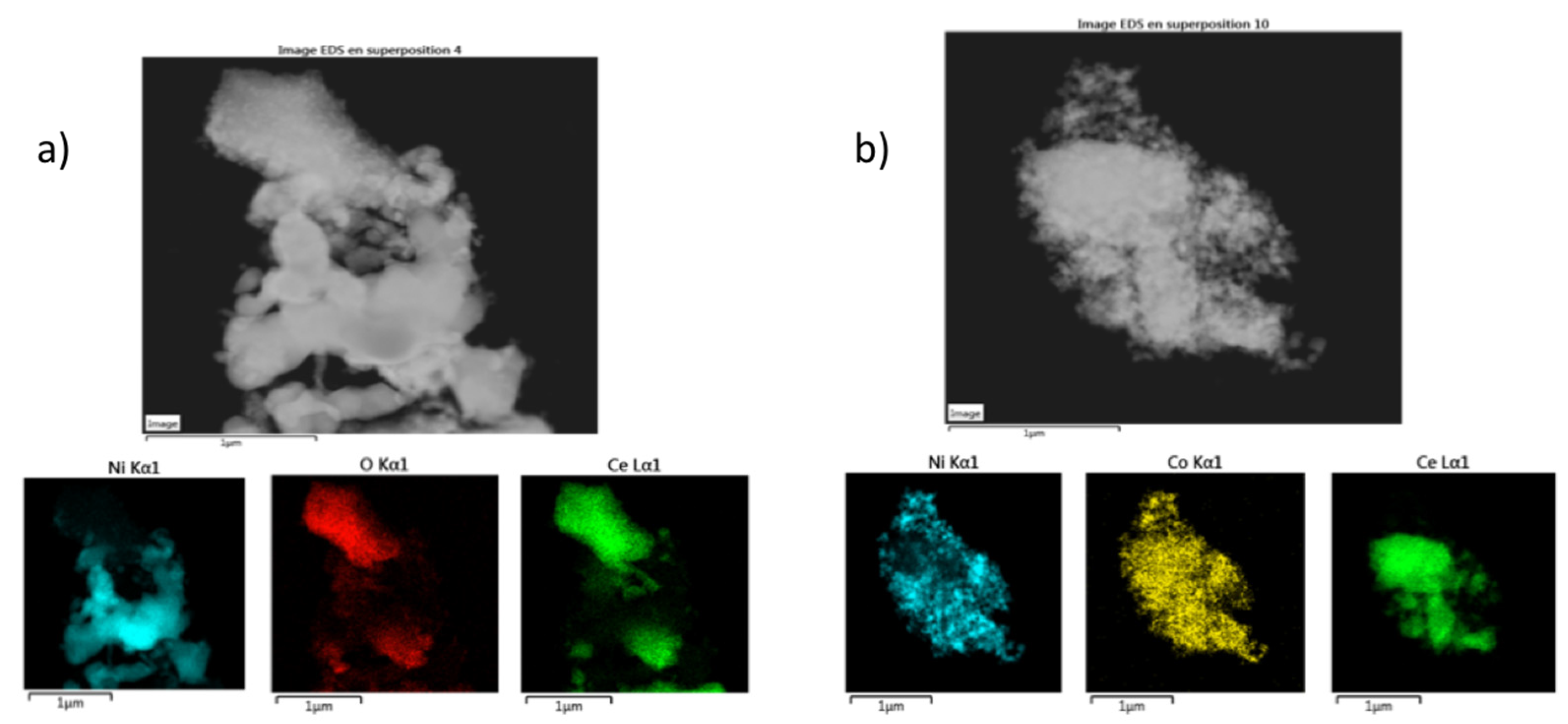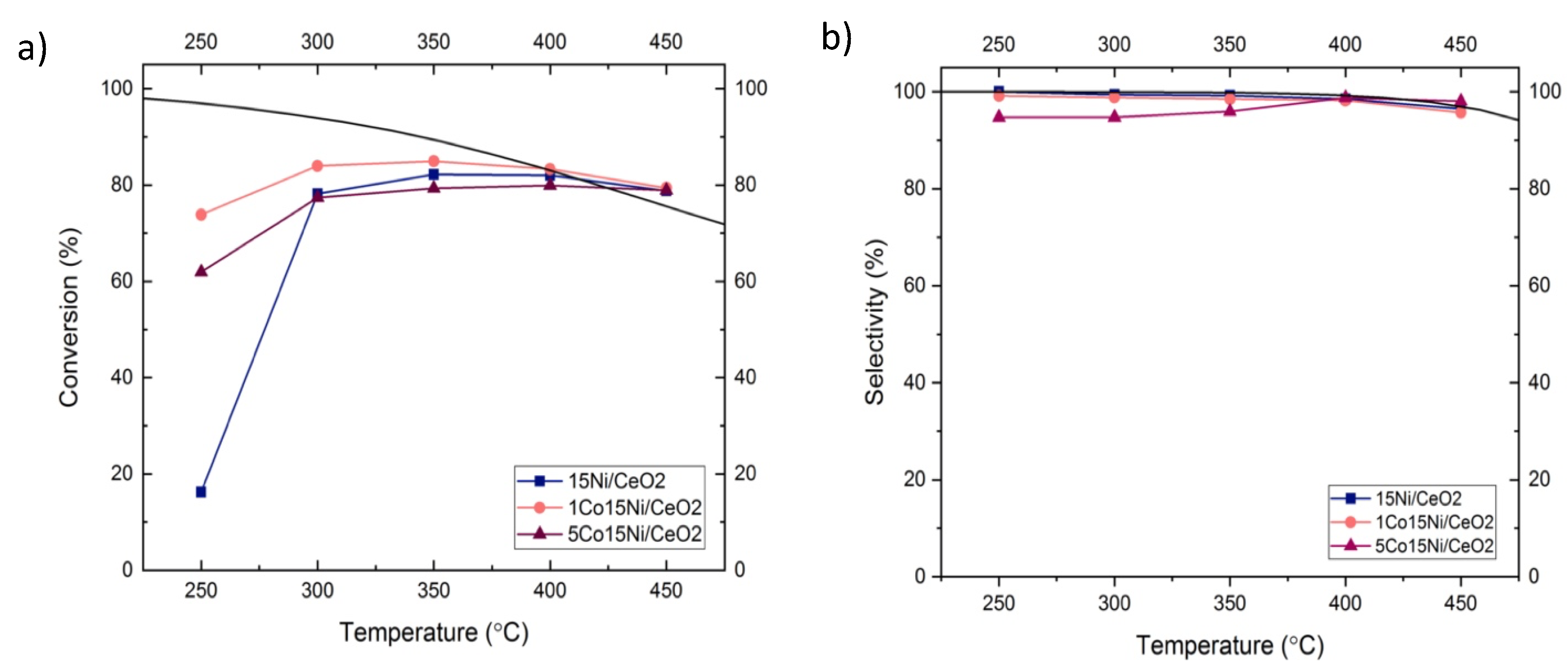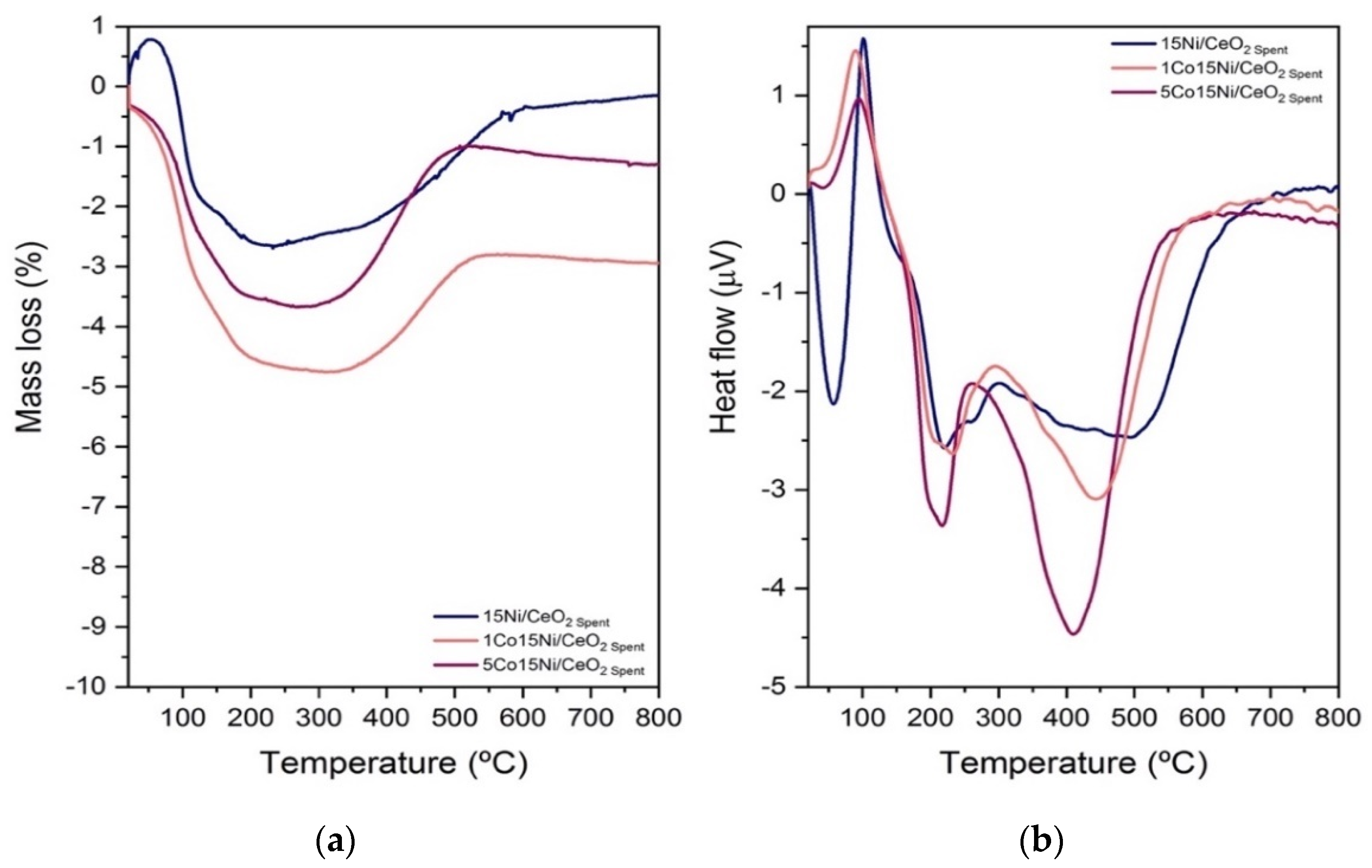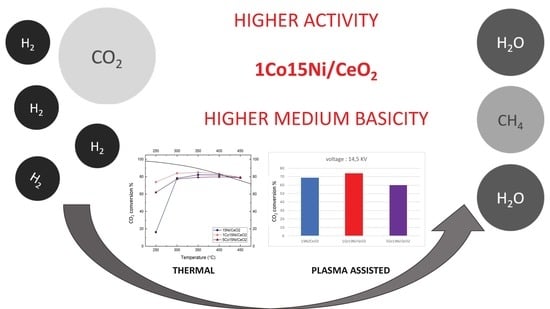On the Effect of Cobalt Promotion over Ni/CeO2 Catalyst for CO2 Thermal and Plasma Assisted Methanation
Abstract
:1. Introduction
2. Results and Discussion
2.1. Characterization Results
2.2. Catalytic Results
2.3. Plasma Assisted Catalytic Methanation
3. Materials and Methods
3.1. Catalysts Synthesis
3.2. Characterization Methods
3.3. Catalytic Runs
3.3.1. Thermal Experiments
3.3.2. Plasma-Assisted Experiments
4. Conclusions
Author Contributions
Funding
Acknowledgments
Conflicts of Interest
References
- Al-Mamoori, A.; Krishnamurthy, A.; Rownaghi, A.A.; Rezaei, F. Carbon Capture and Utilization Update. Energy Technol. 2017, 5, 834–849. [Google Scholar] [CrossRef] [Green Version]
- Baena-Moreno, F.M.; Rodríguez-Galán, M.; Vega, F.; Alonso-Fariñas, B.; Vilches Arenas, L.F.; Navarrete, B. Carbon Capture and Utilization Technologies: A Literature Review and Recent Advances. Energy Sources Part Recovery Util. Environ. Eff. 2019, 41, 1403–1433. [Google Scholar] [CrossRef]
- Huš, M.; Kopač, D.; Strah Štefančič, N.; Lašič Jurković, D.; Dasireddy, V.D.B.C.; Likozar, B. Unravelling the Mechanisms of CO2 Hydrogenation to Methanol on Cu-Based Catalysts Using First-Principles Multiscale Modelling and Experiments. Catal. Sci. Technol. 2017, 7, 5900–5913. [Google Scholar] [CrossRef] [Green Version]
- Leonzio, G. State of Art and Perspectives about the Production of Methanol, Dimethyl Ether and Syngas by Carbon Dioxide Hydrogenation. J. CO2 Util. 2018, 27, 326–354. [Google Scholar] [CrossRef]
- Jurković, D.L.; Pohar, A.; Dasireddy, V.D.B.C.; Likozar, B. Effect of Copper-Based Catalyst Support on Reverse Water-Gas Shift Reaction (RWGS) Activity for CO2 Reduction. Chem. Eng. Technol. 2017, 40, 973–980. [Google Scholar] [CrossRef]
- Bacariza, M.C.; Biset-Peiró, M.; Graça, I.; Guilera, J.; Morante, J.; Lopes, J.M.; Andreu, T.; Henriques, C. DBD Plasma-Assisted CO2 Methanation Using Zeolite-Based Catalysts: Structure Composition-Reactivity Approach and Effect of Ce as Promoter. J. CO2 Util. 2018, 26, 202–211. [Google Scholar] [CrossRef]
- Mierczynski, P.; Mierczynska, A.; Ciesielski, R.; Mosinska, M.; Nowosielska, M.; Czylkowska, A.; Maniukiewicz, W.; Szynkowska, M.I.; Vasilev, K. High Active and Selective Ni/CeO2–Al2O3 and Pd–Ni/CeO2–Al2O3 Catalysts for Oxy-Steam Reforming of Methanol. Catalysts 2018, 8, 380. [Google Scholar] [CrossRef] [Green Version]
- Stangeland, K.; Kalai, D.; Li, H.; Yu, Z. CO2 Methanation: The Effect of Catalysts and Reaction Conditions. Energy Procedia 2017, 105, 2022–2027. [Google Scholar] [CrossRef]
- Frontera, P.; Macario, A.; Ferraro, M.; Antonucci, P. Supported Catalysts for CO2 Methanation: A Review. Catalysts 2017, 7, 59. [Google Scholar] [CrossRef]
- Zheng, J.; Wang, C.; Chu, W.; Zhou, Y.; Köhler, K. CO2 Methanation over Supported Ru/Al2O3 Catalysts: Mechanistic Studies by In Situ Infrared Spectroscopy. ChemistrySelect 2016, 1, 3197–3203. [Google Scholar] [CrossRef]
- Schubert, M.; Pokhrel, S.; Thomé, A.; Zielasek, V.; Gesing, T.M.; Roessner, F.; Mädler, L.; Bäumer, M. Highly Active Co–Al2O3-Based Catalysts for CO2 Methanation with Very Low Platinum Promotion Prepared by Double Flame Spray Pyrolysis. Catal. Sci. Technol. 2016, 6, 7449–7460. [Google Scholar] [CrossRef] [Green Version]
- Kirchner, J.; Anolleck, J.K.; Lösch, H.; Kureti, S. Methanation of CO2 on Iron Based Catalysts. Appl. Catal. B Environ. 2018, 223, 47–59. [Google Scholar] [CrossRef]
- Karelovic, A.; Ruiz, P. CO2 Hydrogenation at Low Temperature over Rh/γ-Al2O3 Catalysts: Effect of the Metal Particle Size on Catalytic Performances and Reaction Mechanism. Appl. Catal. B Environ. 2012, 113–114, 237–249. [Google Scholar] [CrossRef]
- Park, J.-N.; McFarland, E.W. A Highly Dispersed Pd–Mg/SiO2 Catalyst Active for Methanation of CO2. J. Catal. 2009, 266, 92–97. [Google Scholar] [CrossRef]
- Yatagai, K.; Shishido, Y.; Gemma, R.; Boll, T.; Uchida, H.-H.; Oguri, K. Mechanochemical CO2 Methanation over LaNi-Based Alloys. Int. J. Hydrogen Energy 2020, 45, 5264–5275. [Google Scholar] [CrossRef]
- Alrafei, B.; Polaert, I.; Ledoux, A.; Azzolina-Jury, F. Remarkably Stable and Efficient Ni and Ni-Co Catalysts for CO2 Methanation. Catal. Today 2020, 346, 23–33. [Google Scholar] [CrossRef]
- Summa, P.; Świrk, K.; Wang, Y.; Samojeden, B.; Rønning, M.; Hu, C.; Motak, M.; Da Costa, P. Effect of Cobalt Promotion on Hydrotalcite-Derived Nickel Catalyst for CO2 Methanation. Appl. Mater. Today 2021, 25, 101211. [Google Scholar] [CrossRef]
- Nizio, M.; Benrabbah, R.; Krzak, M.; Debek, R.; Motak, M.; Cavadias, S.; Gálvez, M.E.; Da Costa, P. Low Temperature Hybrid Plasma-Catalytic Methanation over Ni-Ce-Zr Hydrotalcite-Derived Catalysts. Catal. Commun. 2016, 83, 14–17. [Google Scholar] [CrossRef] [Green Version]
- Luisetto, I.; Tuti, S.; Di Bartolomeo, E. Co and Ni Supported on CeO2 as Selective Bimetallic Catalyst for Dry Reforming of Methane. Int. J. Hydrogen Energy 2012, 37, 15992–15999. [Google Scholar] [CrossRef]
- Zhou, G.; Liu, H.; Cui, K.; Jia, A.; Hu, G.; Jiao, Z.; Liu, Y.; Zhang, X. Role of Surface Ni and Ce Species of Ni/CeO2 Catalyst in CO2 Methanation. Appl. Surf. Sci. 2016, 383, 248–252. [Google Scholar] [CrossRef]
- Sun, C.; Świrk, K.; Wierzbicki, D.; Motak, M.; Grzybek, T.; Da Costa, P. On the Effect of Yttrium Promotion on Ni-Layered Double Hydroxides-Derived Catalysts for Hydrogenation of CO2 to Methane. Int. J. Hydrogen Energy 2021, 46, 12169–12179. [Google Scholar] [CrossRef]
- Vrijburg, W.L.; Garbarino, G.; Chen, W.; Parastaev, A.; Longo, A.; Pidko, E.A.; Hensen, E.J.M. Ni-Mn Catalysts on Silica-Modified Alumina for CO2 Methanation. J. Catal. 2020, 382, 358–371. [Google Scholar] [CrossRef]
- Wierzbicki, D.; Debek, R.; Motak, M.; Grzybek, T.; Gálvez, M.E.; Da Costa, P. Novel Ni-La-Hydrotalcite Derived Catalysts for CO2 Methanation. Catal. Commun. 2016, 83, 5–8. [Google Scholar] [CrossRef] [Green Version]
- Dębek, R.; Azzolina-Jury, F.; Travert, A.; Maugé, F. A Review on Plasma-Catalytic Methanation of Carbon Dioxide—Looking for an Efficient Catalyst. Renew. Sustain. Energy Rev. 2019, 116, 109427. [Google Scholar] [CrossRef]
- Liu, Q.; Bian, B.; Fan, J.; Yang, J. Cobalt Doped Ni Based Ordered Mesoporous Catalysts for CO2 Methanation with Enhanced Catalytic Performance. Int. J. Hydrogen Energy 2018, 43, 4893–4901. [Google Scholar] [CrossRef]
- Ashford, B.; Wang, Y.; Wang, L.; Tu, X. Plasma-Catalytic Conversion of Carbon Dioxide. In Plasma Catalysis: Fundamentals and Applications; Tu, X., Whitehead, J.C., Nozaki, T., Eds.; Springer Series on Atomic, Optical, and Plasma Physics; Springer International Publishing: Cham, Switzerland, 2019; pp. 271–307. ISBN 978-3-030-05189-1. [Google Scholar]
- Snoeckx, R.; Bogaerts, A. Plasma Technology—A Novel Solution for CO2 Conversion? Chem. Soc. Rev. 2017, 46, 5805–5863. [Google Scholar] [CrossRef] [Green Version]
- Da Costa, P.; Hasrack, G.; Bonnety, J.; Henriques, C. Ni-Based Catalysts for Plasma-Assisted CO2 Methanation. Curr. Opin. Green Sustain. Chem. 2021, 32, 100540. [Google Scholar] [CrossRef]
- Zhou, R.; Rui, N.; Fan, Z.; Liu, C. Effect of the Structure of Ni/TiO2 Catalyst on CO2 Methanation. Int. J. Hydrogen Energy 2016, 41, 22017–22025. [Google Scholar] [CrossRef]
- Mikhail, M.; Da Costa, P.; Cavadias, S.; Tatoulian, M.; Ognier, S.; Galvez, M.E. Nickel Supported Modified Zirconia Catalysts for CO2 Methanation in DBD Plasma Catalytic Hybrid Process. Mater. Sci. Forum 2021, 1016, 894–899. [Google Scholar] [CrossRef]
- Nizio, M.; Albarazi, A.; Cavadias, S.; Amouroux, J.; Galvez, M.E.; Da Costa, P. Hybrid Plasma-Catalytic Methanation of CO2 at Low Temperature over Ceria Zirconia Supported Ni Catalysts. Int. J. Hydrogen Energy 2016, 41, 11584–11592. [Google Scholar] [CrossRef] [Green Version]
- Mikhail, M.; Wang, B.; Jalain, R.; Cavadias, S.; Tatoulian, M.; Ognier, S.; Gálvez, M.E.; Da Costa, P. Plasma-Catalytic Hybrid Process for CO2 Methanation: Optimization of Operation Parameters. React. Kinet. Mech. Catal. 2019, 126, 629–643. [Google Scholar] [CrossRef]
- Biset-Peiró, M.; Guilera, J.; Zhang, T.; Arbiol, J.; Andreu, T. On the Role of Ceria in Ni-Al2O3 Catalyst for CO2 Plasma Methanation. Appl. Catal. Gen. 2019, 575, 223–229. [Google Scholar] [CrossRef]
- Wang, B.; Mikhail, M.; Cavadias, S.; Tatoulian, M.; Da Costa, P.; Ognier, S. Improvement of the Activity of CO2 Methanation in a Hybrid Plasma-Catalytic Process in Varying Catalyst Particle Size or under Pressure. J. CO2 Util. 2021, 46, 101471. [Google Scholar] [CrossRef]
- Chen, H.; Mu, Y.; Shao, Y.; Chansai, S.; Xiang, H.; Jiao, Y.; Hardacre, C.; Fan, X. Nonthermal Plasma (NTP) Activated Metal–Organic Frameworks (MOFs) Catalyst for Catalytic CO2 Hydrogenation. AIChE J. 2020, 66, e16853. [Google Scholar] [CrossRef]
- Zeng, Y.; Tu, X. Plasma-Catalytic Hydrogenation of CO2 for the Cogeneration of CO and CH4 in a Dielectric Barrier Discharge Reactor: Effect of Argon Addition. J. Phys. Appl. Phys. 2017, 50, 184004. [Google Scholar] [CrossRef]
- Chen, H.; Mu, Y.; Shao, Y.; Chansai, S.; Xu, S.; Stere, C.E.; Xiang, H.; Zhang, R.; Jiao, Y.; Hardacre, C.; et al. Coupling Non-Thermal Plasma with Ni Catalysts Supported on BETA Zeolite for Catalytic CO2 Methanation. Catal. Sci. Technol. 2019, 9, 4135–4145. [Google Scholar] [CrossRef]
- Jwa, E.; Lee, S.B.; Lee, H.W.; Mok, Y.S. Plasma-Assisted Catalytic Methanation of CO and CO2 over Ni–Zeolite Catalysts. Fuel Process. Technol. 2013, 108, 89–93. [Google Scholar] [CrossRef]
- Mikhail, M.; Da Costa, P.; Amouroux, J.; Cavadias, S.; Tatoulian, M.; Gálvez, M.E.; Ognier, S. Tailoring Physicochemical and Electrical Properties of Ni/CeZrOx Doped Catalysts for High Efficiency of Plasma Catalytic CO2 Methanation. Appl. Catal. B Environ. 2021, 294, 120233. [Google Scholar] [CrossRef]
- James, O.O.; Maity, S. Temperature Programme Reduction (TPR) Studies of Cobalt Phases in -Alumina Supported Cobalt Catalysts. J. Pet. Technol. Altern. Fuels 2016, 7, 1–12. [Google Scholar] [CrossRef] [Green Version]
- Ge, Y.; He, T.; Han, D.; Li, G.; Zhao, R.; Wu, J. Plasma-Assisted CO2 Methanation: Effects on the Low-Temperature Activity of an Ni–Ce Catalyst and Reaction Performance. R. Soc. Open Sci. 2019, 6, 190750. [Google Scholar] [CrossRef] [Green Version]
- Sayyed, S.A.A.R.; Beedri, N.I.; Kadam, V.S.; Pathan, H.M. Rose Bengal-Sensitized Nanocrystalline Ceria Photoanode for Dye-Sensitized Solar Cell Application. Bull. Mater. Sci. 2016, 39, 1381–1387. [Google Scholar] [CrossRef] [Green Version]
- Benrabbah, R.; Cavaniol, C.; Liu, H.; Ognier, S.; Cavadias, S.; Gálvez, M.E.; Da Costa, P. Plasma DBD Activated Ceria-Zirconia-Promoted Ni-Catalysts for Plasma Catalytic CO2 Hydrogenation at Low Temperature. Catal. Commun. 2017, 89, 73–76. [Google Scholar] [CrossRef] [Green Version]
- Xu, L.; Lian, X.; Chen, M.; Cui, Y.; Wang, F.; Li, W.; Huang, B. CO2 Methanation over CoNi Bimetal-Doped Ordered Mesoporous Al2O3 Catalysts with Enhanced Low-Temperature Activities. Int. J. Hydrogen Energy 2018, 43, 17172–17184. [Google Scholar] [CrossRef]
- Mikhail, M.; Da Costa, P.; Amouroux, J.; Cavadias, S.; Tatoulian, M.; Ognier, S.; Gálvez, M.E. Electrocatalytic Behaviour of CeZrOx-Supported Ni Catalysts in Plasma Assisted CO2 Methanation. Catal. Sci. Technol. 2020, 10, 4532–4543. [Google Scholar] [CrossRef]
- Guo, X.; Traitangwong, A.; Hu, M.; Zuo, C.; Meeyoo, V.; Peng, Z.; Li, C. Carbon Dioxide Methanation over Nickel-Based Catalysts Supported on Various Mesoporous Material. Energy Fuels 2018, 32, 3681–3689. [Google Scholar] [CrossRef]
- Bacariza, M.C.; Amjad, S.; Teixeira, P.; Lopes, J.M.; Henriques, C. Boosting Ni Dispersion on Zeolite-Supported Catalysts for CO2 Methanation: The Influence of the Impregnation Solvent. Energy Fuels 2020, 34, 14656–14666. [Google Scholar] [CrossRef]
- Hołub, M. On the Measurement of Plasma Power in Atmospheric Pressure DBD Plasma Reactors. Int. J. Appl. Electromagn. Mech. 2012, 39, 81–87. [Google Scholar] [CrossRef]
- Xia, H.; Zhang, L.; Hu, H.; Zuo, S.; Yang, L. Efficient Hydrogenation of Xylose and Hemicellulosic Hydrolysate to Xylitol over Ni-Re Bimetallic Nanoparticle Catalyst. Nanomaterials 2020, 10, 73. [Google Scholar] [CrossRef] [PubMed] [Green Version]









| Catalyst | First Main Peak Temperature (°C) | Second Main Peak Temperature (°C) | H2 Consumption [mmol/g] | References |
|---|---|---|---|---|
| CeO2 | 443 | - | 504 | Present Study |
| 15Ni/CeO2 | 268 | 401 | 1086 | Present Study |
| 7.5Ni/CeO2 | 282 | 400 | - | [19] |
| 1Co15Ni/CeO2 | 274 | 401 | 1267 | Present Study |
| 5Co15Ni/CeO2 | 300 | 426 | 1575 | Present Study |
| 3.75Co3.75Ni/CeO2 | 295 | 420 | - | [19] |
| Catalyst | Weak Basic Sites [µmol/g] | Medium Basic Sites [µmol/g] | Strong Basic Sites [µmol/g] | Total Basic Sites [µmol/g] |
|---|---|---|---|---|
| CeO2 | 88 | 16 | - | 103 |
| 15Ni/CeO2 | 33 | 112 | 159 | 304 |
| 1Co15Ni/CeO2 | 67 | 212 | - | 279 |
| 5Co15Ni/CeO2 | 107 | 80 | - | 187 |
| Catalyst | VP (cm3 g−1) | SBET (m2 g−1) |
|---|---|---|
| CeO2 | 0.19 | 258 |
| Ni/CeO2 Reduced | 0.14 | 127 |
| Ni-1Co/CeO2 Reduced | 0.13 | 108 |
| Ni-5Co/CeO2 Reduced | 0.13 | 107 |
| Catalyst | dNiO (nm)Calcined | dNi0 (nm)Reduced | dNi0 (nm)spent |
|---|---|---|---|
| 15Ni/CeO2 | 26 | 38 | 45 |
| 1Co15Ni/CeO2 | 31 | 39 | 38 |
| 5Co15Ni/CeO2 | 31 | 32 | 34 |
| Catalyst | Conversion (%) | Selectivity (%) | GHSV (h−1) b | Ni0 Size (nm) | Basicity (W/M/S) c (µmol/g) | Ref. | ||
|---|---|---|---|---|---|---|---|---|
| 5Co15Ni/Al2O3 | 74 | - | 9554 | - | - | - | - | [16] |
| 5Co20Ni/Al2O3 | 85 | - | 9554 | 13 | - | - | - | [16] |
| 10Co10Ni/Al2O3 | 74 | - | 9554 | 31 | - | - | - | [16] |
| 3Co10Ni/Al2O3 a | 15 | 100 | 10,000 | 3 | - | - | - | [25] |
| 2Co8Ni/Al2O3 a | 60 | 93 | 15,000 | - | - | - | - | [44] |
| HT1Co20Ni | 77 | 99 | 12,000 | 16 | 18 | 66 | 94 | [17] |
| 1Co15Ni/CeO2 | 82 | 98 | 52,000 | 39 | 67 | 212 | 0 | Present study |
| 5Co15Ni/CeO2 | 79 | 95 | 52,000 | 32 | 107 | 80 | 0 | Present study |
| Catalyst | Metals Loading (% wt) (Co/Ni/CeO2) |
|---|---|
| 15Ni/CeO2 | 0/15/85 |
| 5Co15Ni/CeO2 | 5/15/80 |
| 1Co15Ni/CeO2 | 1/15/84 |
Publisher’s Note: MDPI stays neutral with regard to jurisdictional claims in published maps and institutional affiliations. |
© 2021 by the authors. Licensee MDPI, Basel, Switzerland. This article is an open access article distributed under the terms and conditions of the Creative Commons Attribution (CC BY) license (https://creativecommons.org/licenses/by/4.0/).
Share and Cite
Hasrack, G.; Bacariza, M.C.; Henriques, C.; Da Costa, P. On the Effect of Cobalt Promotion over Ni/CeO2 Catalyst for CO2 Thermal and Plasma Assisted Methanation. Catalysts 2022, 12, 36. https://doi.org/10.3390/catal12010036
Hasrack G, Bacariza MC, Henriques C, Da Costa P. On the Effect of Cobalt Promotion over Ni/CeO2 Catalyst for CO2 Thermal and Plasma Assisted Methanation. Catalysts. 2022; 12(1):36. https://doi.org/10.3390/catal12010036
Chicago/Turabian StyleHasrack, Golshid, Maria Carmen Bacariza, Carlos Henriques, and Patrick Da Costa. 2022. "On the Effect of Cobalt Promotion over Ni/CeO2 Catalyst for CO2 Thermal and Plasma Assisted Methanation" Catalysts 12, no. 1: 36. https://doi.org/10.3390/catal12010036
APA StyleHasrack, G., Bacariza, M. C., Henriques, C., & Da Costa, P. (2022). On the Effect of Cobalt Promotion over Ni/CeO2 Catalyst for CO2 Thermal and Plasma Assisted Methanation. Catalysts, 12(1), 36. https://doi.org/10.3390/catal12010036










